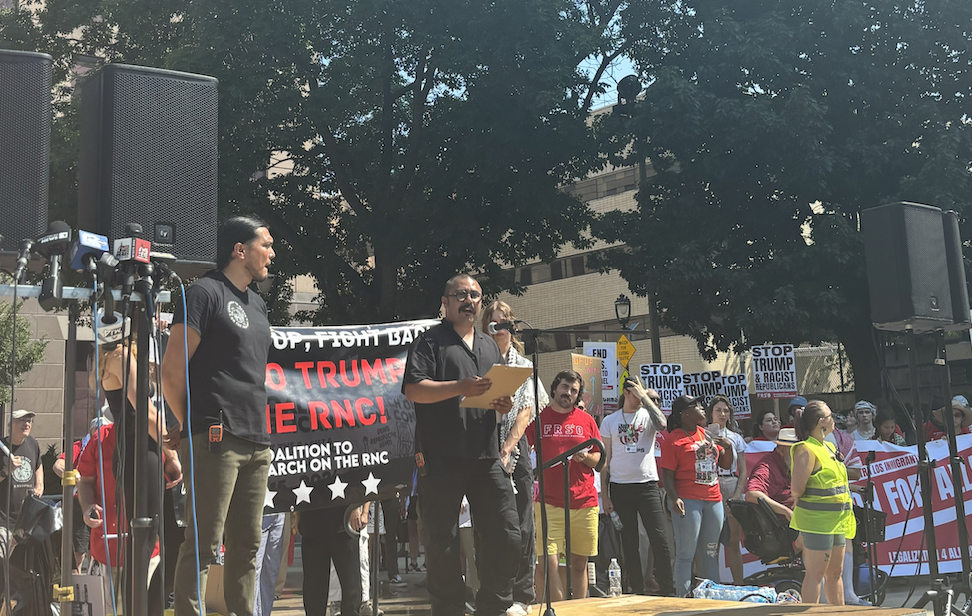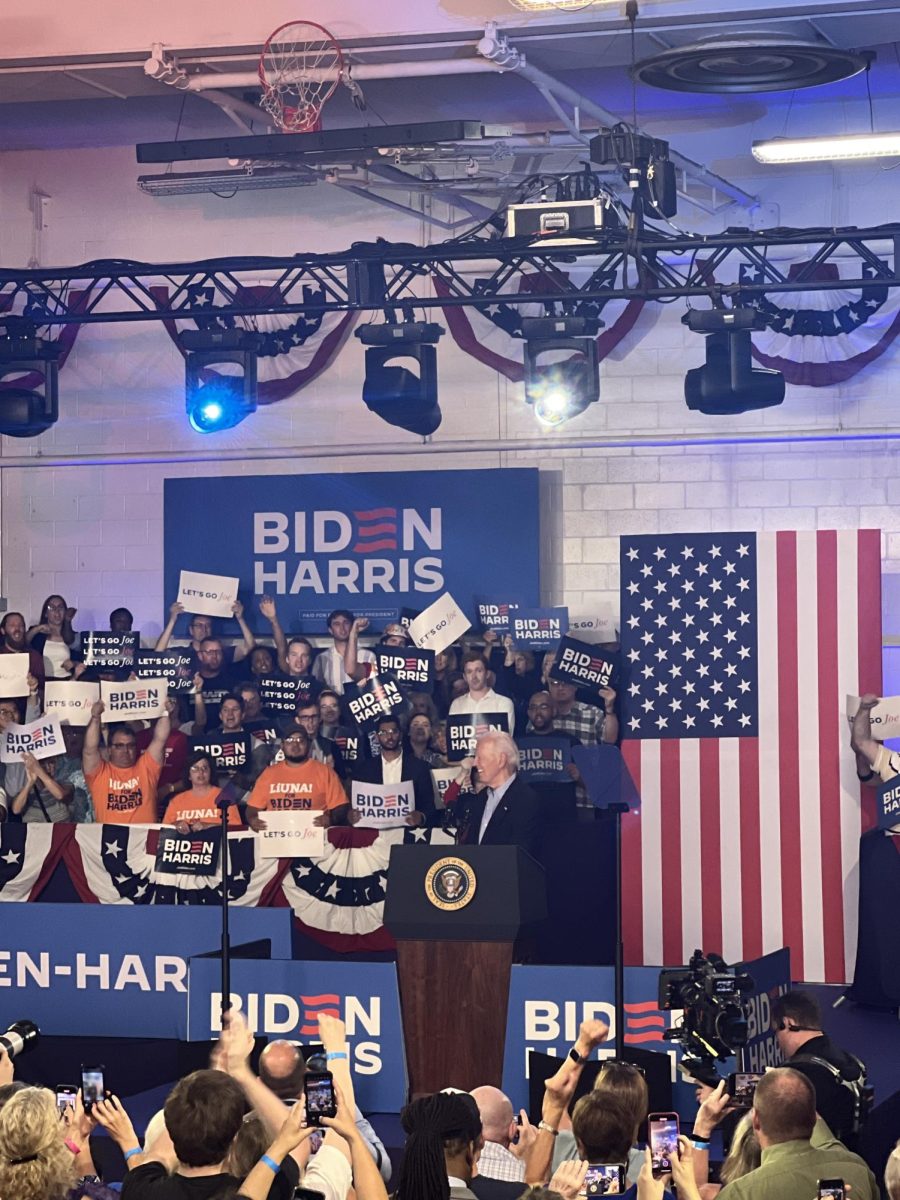A controversial free speech dilemma has bubbled up on the University of Wisconsin campus after two people attending a Badger football game over Halloween weekend wore racially charged costumes and were not ejected from the game.
One of the people was dressed as Donald Trump and the other President Barack Obama wearing a noose and dressed in prison garb.
Attendees alerted UW police and athletic officials and the authorities asked the person wearing the costume to remove the noose. The people were not seated in the student section and officials do not know if they were associated with UW.
Football fan in President Obama mask exercising freedom of speech, chancellor says
Donald Downs, a retired UW political science professor and free speech law expert, said the costume is “sort of a grey area” when it comes to free speech.
“Hanging in effigy” has historically been used symbolically to show constituents’ displeasure with a political or public figure’s time in office, Downs said. But the fact that Barack Obama is black brings in the history of lynching, Downs said.
Downs said the overall message sent could be construed as a political statement, racially motivated sentiment or some combination of the two.
But Downs said the costume would ultimately fall under speech that’s protected from the law.
“If they wore a costume like that around town or on the street corner, that’s going to be protected speech, unless they confront somebody with it, face to face in a threatening manner, in which case it could be construed as a threat,” Downs said.
Ricardo Rangel, a UW junior and member of the Multicultural Greek Council, said he didn’t think it was correct to call the incident free speech because he views it as an act of terror.
Rangel said he was frustrated the administration and authorities pursued the incident as free speech without fully understanding its historical context.
“They didn’t do anything to help the people of color who have fear for their own lives here because of all these actions,” Rangel said.
Hate speech is not expressly excluded from free speech protection of the First Amendment, Downs said. Only speech like threats, child pornography and “fighting words” — words likely to draw someone into a fight — are unprotected. Hate speech alone may be protected, but hate speech aimed at a specific person, for example Obama, would not necessarily be.
But because the football game was a special university event and not a public venue, the university could restrict certain activities and speech. Downs said the noose fit into a category the university could ban, but was still an ambiguous symbol.
Downs said the university found a middle ground in the tension between protecting free speech and preventing hate speech by asking the person to remove the noose.
The day following the incident, UW Chancellor Rebecca Blank said in a statement the political message, though hateful, constituted free speech.
“As offensive as this costume was, I believe our university must resist the desire to outlaw forms of speech and political dissent with which we disagree,” Blank said in the statement.
Blank also said the incident is a further reminder more work needs to be done to build a stronger, more inclusive community.
At a Faculty Senate meeting Monday, Blank further apologized for the university’s handling of the incident, announcing UW has since revoked the attendees’ season tickets. UW will also unveil new carry in policies by the end of the week.
UW Athletics also said in a statement while they consider the costume “repugnant,” the costumes are still an exercise of the individuals’ free speech.
exercising your 1st amendment rts doesn't require good taste. Showin up #Badger in Obama mask & a noose around his neck is a prime example.
— Sue Riseling (@RiselingGroup) October 30, 2016
In a letter to Blank, Associated Students of Madison Chair Carmen Goséy and three other ASM members said they disapproved of initial statements from UW Athletics addressing the incident.
“This image incites violence and carries a dark history of oppression and terrorization from white supremacist groups,” they said in the letter. “This is hate speech that continues to ostracize Black people on campus, instill fear, and threaten safety.”
The representatives criticized the university for claiming to support diversity and inclusivity but choosing “not to uphold these values at a time of need.” They said short-term diversity initiatives were not enough to stand in for more sustained efforts.
Blank and Athletic Director Barry Alvarez said in a later statement Camp Randall will review its policies “with the goal of ensuring that symbols of this type are not displayed in our stadium again.”
UW reviews Camp Randall policies after public backlash over Halloween incident
Aria Bryan, a UW junior and member of the Black Student Union, Wunk Sheek — an organization for students of indigenous background — and Mixed Race Student Union, said she was initially confused when she heard about the costume incident.
“Mentally, I was trying to get around the fact that this was a racially-charged costume,” Bryan said. “I was just kind of confused and trying to process what angle this was coming from.”
Bryan said when she fully understood the implications of the costume, she felt anger and shock.
She said she appreciated the university’s efforts to look forward and make sure oppressive events don’t go unpunished.
“It’s good that they’re taking steps toward ensuring this doesn’t happen again in the future, but I want them to do more with regards to this specific case, because I don’t want there to be a set precedent that people can get away with things like this,” Bryan said.
But Bryan said as a Native American and African American student, she is no stranger to seeing culturally offensive images for Halloween.
It is disheartening to still see racial bias after eight years of what was supposed to be change under the country’s first African American president, Bryan said. She said the costume incident is not reflective of the Madison community, but of a society that needs to be more racially and historically aware.
“I’m not naive enough to think that it doesn’t happen,” Bryan said. “I hope that students and teachers and anyone that’s been affected really understand that there’s a huge difference in trying to make a political statement or trying to make a joke or funny costume than completely insulting somebody’s identity.”
Vershawn Hansen, a UW freshman and first year ambassador for Wisconsin Black Student Union, said when he saw Blank’s statement he didn’t understand her interpretation of free speech.
“As a freshman, I was shocked that it was handled that way,” Hansen said. “It almost … covered up and swept under the rug by calling this free speech.”
Hansen said as a member of the black community, he doesn’t consider Blank an ally at the moment. But he appreciated the national spotlight on the incident as a way to encourage action on the part of the institution.
Hoyon Mephokee, a UW senior, former Asian American Student Union president and current senior advisor, said the university hasn’t taken the incident as seriously as he would have hoped.
“It’s not just this event,” Mephokee said. “I think it reflects a trend that many people of color and other socially or economically disadvantaged people feel that their very legitimate struggles and concerns aren’t being taken seriously by the administration.”
Mephokee said students are leading much of the action to counter these types of incidents, including cultural competency initiatives. He said it is not enough for the administration to issue statement after statement when events like this occur.
“I’m not saying the administration isn’t taking any action,” Mephokee said. “The administration certainly is responding to these events, as are students on ASM and other leadership positions. I just think that the fact we’re seeing this sort of behavior continue — it’s indicative that clearly more can be done.”
Programs to encourage better cultural understanding could be effective given enough time and focus, Mephokee said. He said while changing Camp Randall’s costume policies will help, it alone won’t get to the heart of the problem.
Rangel said the university was more concerned with preserving its reputation than the lives of students on campus.
He said it is frustrating to deal with these issues on a day-to-day basis and all minorities see and have a voice in these situations.
“Racism is racism, regardless of what your ethnicity is,” Rangel said. “We should all be united in order to fight racism.”
Major hate and bias controversies in 2016

UW officials respond to swastika ‘bias incident’ in campus dorm
UW officials respond to ‘war chant’ incident at Native American community gathering
UW First Wave scholar subjected to hateful language, spit on face in campus dorm
Graffiti at Wisconsin Institutes for Discovery follows series of campus hate, bias incidents
University official confirms new incident of hate and bias on campus
[UPDATED]: Anti-Semitic, white supremacist graffiti found in UW’s Greek life community
[UPDATED] Anti-Semitic graffiti reported in Sellery Residence Hall
Football fan in President Obama mask exercising freedom of speech, chancellor says


















